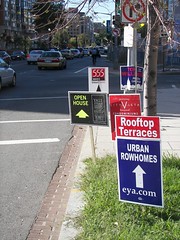Why I get tired of the hand-wringing over affordable housing
 Housing sign garden at 4th and Massachusetts Avenue NW.
Housing sign garden at 4th and Massachusetts Avenue NW.Because for the most part, people miss the point.
If there wasn't a length restriction, this would be my response to the Metropolis Magazine article, "The Vanishing Class: Middle-income neighborhoods are disappearing from cities, and in New York they’re being squeezed to the very edge."
The article talks about prefabricated housing as a way to reduce the cost of labor in housing production. And that's important, but roughly equal to the importance of hybrid cars in terms of the negligible impact on reducing "the addiction to oil" in the asphalt nation. In other words, it doesn't do much.
----------
Have you never read Jane Jacobs? The whole point about a "large stock of old buildings" is to provide low cost access to whatever. This includes housing.
By definition, new construction cannot generate affordable housing, unless it is subsidized. (With density bonuses, free land, cut-rate financing, etc.) Otherwise, the cost of labor, land, and materials doesn't vary when you're building market-rate vs. affordable housing.
Market forces will always direct construction to the area of the most profitable return, which isn't affordable housing.
A marginal increase in demand for urban living, in particular, historic housing stock, which by definition is a finite and shrinking resource means that housing costs go up in strong real estate markets, further pricing out people of lesser means. (That is what's happening in Washington, DC. On the other hand, you can buy houses for $60,000 in metropolitan Pittsburgh.)
As long as property taxes are based on property value, not income, people of lesser means will eventually be priced out of strong real estate markets.
The only way to protect "affordable housing" is to somehow to extract it from the market. This does have a downside of reducing the appreciation potential.
And the methodology for how property taxes are levied must be addressed.
Likely, this means moving properties into community land trusts, cooperative setups, etc.
And cities need to take an active role in both production of housing (this doesn't necessarily mean construction by the city government proper, but it means providing buildings or land with covenants protecting affordability in perpetuity) and stabilization of rents (such as the wide variety of programs in NYC).
Affordable housing requirements for new construction doesn't have all that much impact, as important as they are, because the majority of housing is extant, and inclusionary zoning is irrelevant to maintaining affordability.
Also see "Affordable Housing and Historic Preservation: The Missed Connection," by Don Rypkema.
Index Keywords: housing



0 Comments:
Post a Comment
<< Home